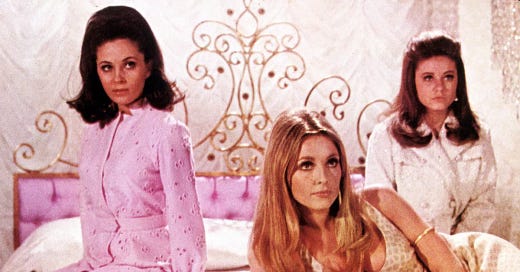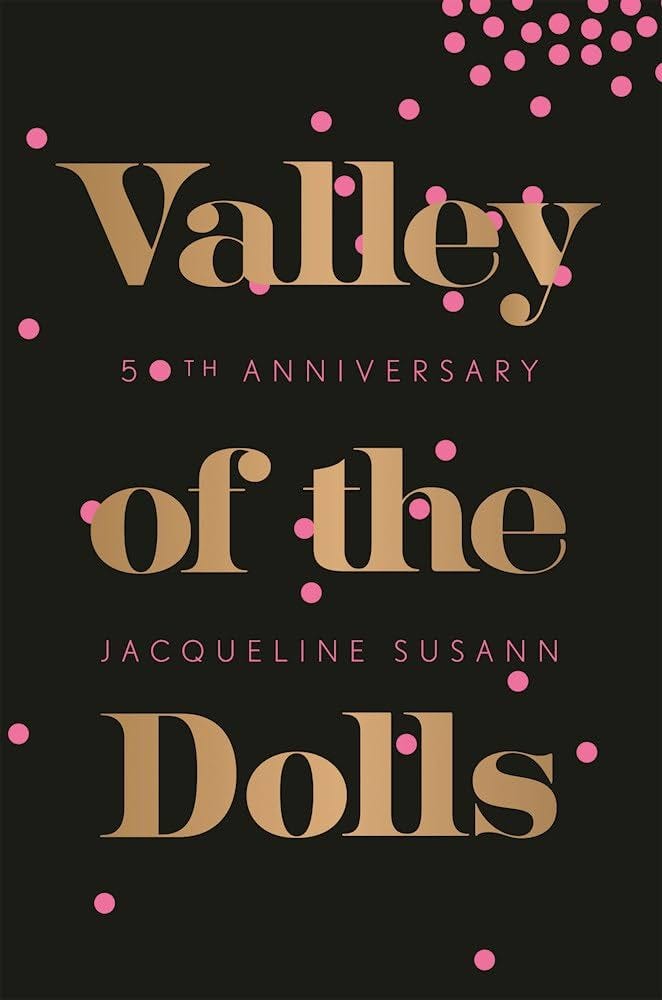Our final summer read is a pop-culture classic that shook the world when it was first published in 1966. This tale of three fame-seeking women in New York traces their climb to the top of the entertainment world, only to find there’s nowhere to go but down — into The Valley of the Dolls. Half a century later, it feels as relevant as ever.
Slurring soubrettes, popping champagne corks, and retina-shorching flashbulbs. Busty chicks raking in the cash despite a glaring lack of talent. Body conscious A-listers doing anything and everything to "lose the baby weight.” Clandestine shags, brittle egos, and lesbian trysts. Sounds like today? Baby, this was half a century ago!
So begins the 50th anniversary version of the text, which compares how accurately the book predicted our current social-media fueled, image-obsessed modern era.
The Valley of the Dolls painted a dark picture of Post War America that has been described as “a grim fable. It’s Thomas Hardy dark. It’s Balzac bleak. It’s Dostoyevsky greige. Nothing ends well. Success corrupts. Fame destroys. Everyone is a mess. It is, in other words, the perfect mirror for today’s culture.” - Simon Doonan, Slate.
Jaqueline Susann’s iconic novel has been described as kitsch, camp, trashy, and classic. Regardless of the division, it was an undisputed success — topping the best seller charts for 26 weeks, selling 31 million copies in 30 languages, and being adapted into a 1967 film (which the author apparently hated). See the trailer below.
So is it trashy? Or timeless? Let’s read it and discuss!
Regardless, it’s not hard to imagine the three ambitious women at the center of the story as modern influencers today. And what drives them — fame — and bedevils them — aging — remains the same double edged sword of celebrity today.
Age settled with more grace on ordinary people, but for celebrities — woman stars in particular — age became a hatchet that vandalized a work of art.
But what intrigues me about this story is the way it describes the ephemeral nature of fame, which can become a Sword of Damocles for the chosen few on the top. As one of my Hollywood friends describes the industry: “Here today, gone today.”
Perhaps that’s why the characters fall into addiction to “dolls” — the myriad of uppers and downers they rely upon to cope with the stresses of fame. All this makes me feel like this throwback novel will be a good mirror for our current era — and a nice contrast to the boyish adventurism of The Dharma Bums.
As always, my monthly book club recommendations remain free to all readers. If you’d like to take part in our live book club discussions you can join us by upgrading to a paid subscription at any time. The next one is this Thursday August 3rd for last month’s book, The Dharma Bums.
For those of you who were alive when The Valley of the Dolls was first published, let me know if you read the book or saw the movie when it came out. And in the meantime, I’ll leave you with some reading music — one of the many covers of the movie’s theme song, this one from one of my favorite albums: Afro-Harping by Dorothy Ashby.
Happy reading! Tag me in your #MarkoBookClub selfies and enjoy the rest of summer!
Best,
Marko







No comments? Hmm ... me thinks there is some ageism here. Maybe most of your subscribers are too young for this nostalgia, but I think the parallels you drew are spot on. I do remember when every third person seemed to be carrying a copy of this book and talking about the movie. Your piece made me realize the how destructive fame can be, not just to people, but to the inanimati (inanimate objects elevated to notoriety) as well. Valium got the bad rap from the Stones, drawing the attention and ire of the drug police.
Valium or diazepam quickly had gained immense popularity with doctors and patients. Between 1969 and 1982, Valium was the most prescribed drug in the US, and sales peaked in 1978 with more than 2.3 billion pills sold that year. But the haters won out.
Initially, there was a lot of enthusiasm in the medical field for replacing barbiturates with diazepam. Unlike the older drugs, diazepam is a more effective anxiolytic, it is much less likely to result in lethal overdose, and it is said to have a lower potential for abuse and dependence.
During the 1980s and 1990s, however, the use of diazepam and other BZDs became more controversial. Though many psychiatrists continued to view these drugs as valuable tools for treating anxiety disorders, concerns about overprescribing benzodiazepines, as well as their potential for abuse and dependence, mounted and have led to a decline in the popularity of diazepam. So one of the safest drugs in it’s class - te best muscle relaxant ever compounded and the most effective anti-seizure drug became a pariah, at least in America,
Because of its status as the most famous Benzodiazepine —“Mother’s Little Helper”—as the Rolling Stones called it in their 1966 hit song—many people had heard of Valium and viewed it as a dangerous, overprescribed, habit-forming drug. Fame is a fatal flame.